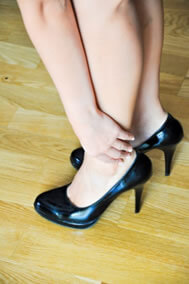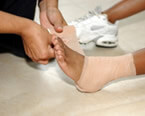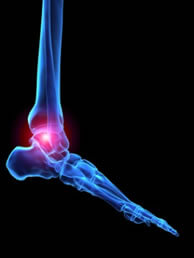Connect With Us
Blog
Items filtered by date: November 2016
Long Term Concerns can arise from High Heels
 Although high heels may be a popular fashion staple, if worn for long periods of time, heels can damage the feet as pressure is increased on the balls of the feet and the toes are squeezed together. Long-term issues can also result from wearing high heels, such as bunions, hammertoe, nerve pain, corns and blisters. Thinner and higher heels “will increase the chances of ankle sprains and other soft tissue injuries, as well as alter your posture which can lead to knee and lower back pain.” Thicker and lower heels are safer as the foot loses less balance and puts less pressure on the balls of our feet.
Although high heels may be a popular fashion staple, if worn for long periods of time, heels can damage the feet as pressure is increased on the balls of the feet and the toes are squeezed together. Long-term issues can also result from wearing high heels, such as bunions, hammertoe, nerve pain, corns and blisters. Thinner and higher heels “will increase the chances of ankle sprains and other soft tissue injuries, as well as alter your posture which can lead to knee and lower back pain.” Thicker and lower heels are safer as the foot loses less balance and puts less pressure on the balls of our feet.
High heels have a history of causing foot and ankle problems. If you have any concerns about your feet or ankles, contact Dr. Harry I. Zirna from Lockport Foot Care, PLLC. Dr. Zirna will assist you with all your podiatric concerns.
Effects of High Heels on the Feet
High heels are popular shoes among women because their style and societal appeal. Despite this, they can still cause many health problems if worn too frequently.
What parts my body will be affected by high heels?
- Ankle Joints
- Achilles Tendon – may shorten and stiffen with prolonged wear
- Balls of the Feet
- Knees – heels cause the knees to bend constantly, creating stress on them
- Back – they decrease the spine’s ability to absorb shock, which may lead to back pain. Also, the vertebrae of the lower back may compress.
What kinds of foot problems can develop from wearing high heels?
- Corns
- Calluses
- Hammertoe
- Bunions
- Morton’s Neuroma
- Plantar Fasciitis
How can I still wear high heels and maintain foot health?
If you want to wear high heeled shoes, make sure that you are not wearing them every day, as this will help prevent long term physical problems. Try wearing thicker heels as opposed to stilettos to distribute weight more evenly across the feet. Always make sure you are wearing the proper shoes for the right occasion, such as sneakers for exercising. If you walk to work, try carrying your heels with you and changing into them once you arrive at work. Adding inserts to your heels can help cushion your feet and absorb shock. Full foot inserts or metatarsal pads are available.
If you have any questions, please feel free to contact our offices in Lockport and Medina, NY. We offer the newest diagnostic and treatment technologies for all your foot care needs.
What Causes Bunions?
 Bunions can be described as the bony deformities of our foot’s joints. There are several factors that can contribute to the forming and progression of bunions, such as genetics, arthritis, previous injuries and long-term use of improperly-fitting shoes such as high heels. Shoes can play a large role in the overall comfort of our feet, especially for those of us who are avid runners, so it’s important to find the proper shoes to prevent the development of problems such as bunions. If left untreated, bunions may require orthotics and possibly even surgery if they become too severe. Wild neutral running shoes are recommended for women who have arched and neural feet that do not roll inwards or outwards. Wild stability running shoes are recommended for those who have lower-arched feet that tend to roll inward. Wide motion-control running shoes are ideal for those who have flat feet
Bunions can be described as the bony deformities of our foot’s joints. There are several factors that can contribute to the forming and progression of bunions, such as genetics, arthritis, previous injuries and long-term use of improperly-fitting shoes such as high heels. Shoes can play a large role in the overall comfort of our feet, especially for those of us who are avid runners, so it’s important to find the proper shoes to prevent the development of problems such as bunions. If left untreated, bunions may require orthotics and possibly even surgery if they become too severe. Wild neutral running shoes are recommended for women who have arched and neural feet that do not roll inwards or outwards. Wild stability running shoes are recommended for those who have lower-arched feet that tend to roll inward. Wide motion-control running shoes are ideal for those who have flat feet
Untreated bunions can make walking uncomfortable. If you are suffering from bunions, contact Dr. Harry I. Zirna from Lockport Foot Care, PLLC. Dr. Zirna will attend to all of your foot and ankle needs and answer any of your related questions.
What is a Bunion?
A bunion is formed of swollen tissue or an enlargement of boney growth, usually located at the base joint of the toe that connects to the foot. The swelling occurs by the bones in the big toe shifting inward, which impacts the other toes of the foot. This causes the area around the base of the big toe to become inflamed and painful.
Why do Bunions Form?
- Genetics – susceptibility to bunions are often hereditary
- Stress on the feet – poorly fitted and uncomfortable footwear that places stress on feet, such as heels, can cause bunions to form
How are Bunions Diagnosed?
Doctors often perform two tests – blood tests and x-rays – when trying to diagnose bunions, especially in the early stages of development. Blood tests help determine if the foot pain is being caused by something else, such as arthritis, while x-rays provide a clear picture of your bone structure to your doctor.
How are Bunions Treated?
- Refrain from wearing heels or similar shoes that cause discomfort
- Select wider shoes that can provide more comfort and reduce pain
- Anti-inflammatory and pain management drugs
- Orthotics or foot inserts
- Surgery
If you have any questions, please feel free to contact our offices located in Lockport and Medina, NY. We offer the newest diagnostic and treatment technologies for all your foot care needs.
All About Stress Fractures
 The fifth metatarsal is the long bone that connects to the pinky toe on the outside of the foot. This bone is especially prone to fracture for people involved in any sort of prolonged physical activity, especially team sports. This is one of the most common injuries in soccer, but many other athletes also suffer this injury. It is vitally important to never ignore any type of foot pain, on the field or off. Professionally, there is immense pressure to perform, which can lead to dependency on prescription painkillers. But the truth is, we all need our feet, not just star athletes. The best course of action is always to contact a podiatrist and get to the root of the problem.
The fifth metatarsal is the long bone that connects to the pinky toe on the outside of the foot. This bone is especially prone to fracture for people involved in any sort of prolonged physical activity, especially team sports. This is one of the most common injuries in soccer, but many other athletes also suffer this injury. It is vitally important to never ignore any type of foot pain, on the field or off. Professionally, there is immense pressure to perform, which can lead to dependency on prescription painkillers. But the truth is, we all need our feet, not just star athletes. The best course of action is always to contact a podiatrist and get to the root of the problem.
Activities where too much pressure is put on the feet can cause stress fractures. To learn more, contact Dr. Harry I. Zirna from Lockport Foot Care, PLLC. Dr. Zirna can treat your foot and ankle concerns.
Dealing with Stress Fractures of the Foot and Ankle
The Stress Fractures occur on the foot and ankle when muscles in these areas weaken from too much or too little use. Then the feet and ankles lose support when walking or running from the impact of the ground. Since there is no protection the bones receive the full impact of each step. The stress on the feet causes cracks to form in the bones, thus called stress fractures.
What are Stress Fractures?
Stress fractures occur frequently in individuals whose daily activities cause great impact on the feet and ankles. Stress factors are most common among:
-runners
-people affected with Osteoporosis
-play tennis or basketball
-gymnastics
-high impact workouts
Symptoms
Pain from the fractures occur in the area of the fractures, and can be constant or intermittent. It will often cause sharp or dull pain with swelling and tenderness. Engaging in any kind of activity which involves in high impact will aggravate pain.
If you have any questions, please feel free to contact our offices in Lockport and Medina, NY. We offer the newest diagnostic and treatment technologies for all your foot care needs.
Vince Biegel Sidelined With Broken Foot
 Wisconsin senior linebacker Vince Biegel was sidelined for several weeks following a broken foot injury in late September. Biegel had to undergo surgery after meeting with the team’s physicians. “Vince has such a passion for football and loves playing the game.… What you appreciate is that you know he will do everything in his power to get back on the field as soon as possible,” said UW coach Paul Chryst in a press release.
Wisconsin senior linebacker Vince Biegel was sidelined for several weeks following a broken foot injury in late September. Biegel had to undergo surgery after meeting with the team’s physicians. “Vince has such a passion for football and loves playing the game.… What you appreciate is that you know he will do everything in his power to get back on the field as soon as possible,” said UW coach Paul Chryst in a press release.
Sports related foot and ankle injuries need proper treatment before players can go back to their regular routines. For more information, contact Dr. Harry I. Zirna from Lockport Foot Care, PLLC. Dr. Zirna can provide the care you need to keep you pain-free and on your feet.
Sport Related Foot and Ankle Injuries
Foot and ankle injuries are a common occurrence when it comes to athletes of any sport. While many athletes dismiss the initial aches and pains, the truth is that ignoring potential foot and ankle injuries can lead to serious problems. As athletes continue to place pressure and strain the area further, a mild injury can turn into something as serious as a rupture and may lead to a permanent disability. There are many factors that contribute to sports related foot and ankle injuries, which include failure to warm up properly, not providing support or wearing bad footwear. Common injuries and conditions athletes face, including:
- Plantar Fasciitis
- Plantar Fasciosis
- Achilles Tendinitis
- Achilles Tendon Rupture
- Ankle Sprains
Sports-related injuries are commonly treated using the RICE method. This includes rest, applying ice to the injured area, compression and elevating the ankle. More serious sprains and injuries may require surgery, which could include arthroscopic and reconstructive surgery. Rehabilitation and therapy may also be required in order to get any recovering athlete to become fully functional again. Any unusual aches and pains an athlete sustains must be evaluated by a licensed, reputable medical professional.
If you have any questions please feel free to contact one of our offices located in Lockport and Medina, NY. We offer the newest diagnostic and treatment technologies for all your foot and ankle needs.
Treating Toenail Fungus
 Toenail fungus is difficult to hide and at times, may be difficult to treat. Fortunately, there are ways to get rid of it. Nail fungus starts off as a white or yellow spot underneath your toenail. As the fungal infection progresses, it may cause your nail to change color, thicken, or crumble at the edge. Toenail fungus can usually be treated by medicated nail polish, oral antibiotics, medicated nail cream, or nail removal.
Toenail fungus is difficult to hide and at times, may be difficult to treat. Fortunately, there are ways to get rid of it. Nail fungus starts off as a white or yellow spot underneath your toenail. As the fungal infection progresses, it may cause your nail to change color, thicken, or crumble at the edge. Toenail fungus can usually be treated by medicated nail polish, oral antibiotics, medicated nail cream, or nail removal.
For more information about treatment, contact Dr. Harry I. Zirna from Lockport Foot Care, PLLC. Dr. Zirna will attend to your foot and ankle needs.
Toenail Fungus Treatment
Toenail fungus is a problem which affects many people and is hard to get rid of. Fortunately, there are several methods to go about treating toenail fungus.
Antibiotics & Treatments
Lamisil – is the most commonly effective treatment for toenail fungus. It is available as an antibiotic Terbinafine tablet and cream. Terbinafine is a chemical component which kills fungal growth on the body. Applying regular doses will gradually kill the fungal growth. It is important to keep the area clean and air free.
Talcum powder – applying powder on the feet and shoes helps keep the feet free of moisture and sweat.
Sandals or open toed shoes – wearing these will allow air movement and help keep feet dry. They also expose your feet to light, which fungus cannot tolerate. Socks with moisture wicking material also help as well
Alternative Treatments
There are always surgical procedures that are available for toenail fungus. Some people would like immediate quick removal of toenail fungus. Surgeons will be able to cut through and remove the growth using laser surgery. It is important not to try and remove it yourself. Once removed, your old shoes will need to be replaced to avoid reinfection.
If you have any questions please feel free to contact one of our offices located in Lockport and Medina, NY. We offer the newest diagnostic and treatment technologies for all your foot and ankle needs.
Blog Archives
- March 2024
- February 2024
- January 2024
- December 2023
- November 2023
- October 2023
- September 2023
- August 2023
- July 2023
- June 2023
- May 2023
- April 2023
- March 2023
- February 2023
- January 2023
- December 2022
- November 2022
- October 2022
- September 2022
- August 2022
- July 2022
- June 2022
- May 2022
- April 2022
- March 2022
- February 2022
- January 2022
- December 2021
- November 2021
- October 2021
- September 2021
- August 2021
- July 2021
- June 2021
- May 2021
- April 2021
- March 2021
- February 2021
- January 2021
- December 2020
- November 2020
- October 2020
- September 2020
- August 2020
- July 2020
- June 2020
- May 2020
- April 2020
- March 2020
- February 2020
- January 2020
- December 2019
- November 2019
- October 2019
- September 2019
- August 2019
- July 2019
- June 2019
- May 2019
- April 2019
- March 2019
- February 2019
- January 2019
- December 2018
- November 2018
- October 2018
- September 2018
- August 2018
- July 2018
- June 2018
- May 2018
- April 2018
- March 2018
- February 2018
- January 2018
- December 2017
- November 2017
- October 2017
- September 2017
- August 2017
- July 2017
- June 2017
- May 2017
- April 2017
- March 2017
- February 2017
- January 2017
- December 2016
- November 2016
- October 2016
- September 2016
- August 2016
- July 2016
- June 2016
- May 2016
- April 2016
